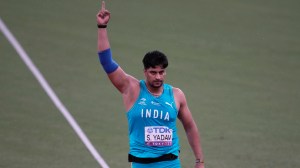SSP — Centre and states squabble over legal technicalities
NEW DELHI, JAN 14: What exactly is the meaning of the word ``arguably''? The Centre and two states have been squabbling over it in context...

NEW DELHI, JAN 14: What exactly is the meaning of the word “arguably”? The Centre and two states have been squabbling over it in context of the controversial Sardar Sarovar Project (SSP).
Reason: Attorney general Soli Sorabjee used that word while giving a written opinion on the options available following the Supreme Court’s go-ahead to the SSP.
What is at stake is whether an irrigation by pass tunnel (IBPT), not part of the original project, can now be built to ensure that Gujarat gets the usual quantity of water even when there is a breakdown in the powerhouse at the dam.
In the normal course, Gujarat will get its share of water from the dam only after it turns the five turbines comprising the powerhouse. Gujarat wants the IBPT built so that water can be released through it whenever any of the turbines break down.
But Madhya Pradesh fears that it will lose power as it will not be able to check the amount of water drawn by Gujarat through the IBPT.
Since the SSP is an inter-state project, the Centre monitors its progress through Narmada Control Authority (NCA) under the terms of the Narmada Water Dispute Tribunal Award given way back in 1979.
When the NCA backed Gujarat’s stand on the IBPT, Madhya Pradesh raised a legal objection: How can the NCA have any jurisdiction over the IBPT given that no such tunnel was envisaged at all by the 1979 Award?
Madhya Pradesh’s objection was later referred to Sorabjee for his opinion on whether the NCA enjoyed jurisdiction over the IBPT proposal. As it happened, Sorabjee did not give a clear yes or no. Instead, he wrote it could be “arguably” said the NCA had jurisdiction to discuss the IBPT proposal.
At a meeting held two days ago in New Delhi, Union Water Resources Minister Arjun Charan Sethi and Gujarat Chief Minister Keshubhai Patel took Sorabjee’s opinion to mean that the NCA did have a say on the IBPT issue. But Madhya Pradesh Chief Minister Digvijay Singh said his government had consulted three eminent lawyers whose interpretation of Sorabjee’s opinion was very different from that of the Centre and Gujarat.
This split, with Sethi and Patel on the one side and Digvijay Singh on the other, came to the fore at the Review Committee of the NCA, when it met two days ago for the first time since the apex court judgment of October 2000.
The meeting also brought out the fact that Madhya Pradesh’s priorities regarding the SSP changed radically after formation of Chattisgarh. The hydroelectricity generated by the SSP has suddenly acquired greater value for Madhya Pradesh prompting Singh to declare that his government was “totally committed to the completion” of the SSP.
Digvijay Singh’s new-found enthusiasm for the SSP is because Madhya Pradesh has lost the coal belt, its biggest source of power, to Chattisgarh. And the 1,035 MW-SSP has the potential to make up substantially for the loss of thatthermal energy.
As per the Tribunal Award of 1979, Madhya Pradesh is entitled to as much as 57 per cent of power generated by the inter-state SSP. The prospect of this additional power has now influenced Madhya Pradesh to take in its stride the mammoth problems it will have to face due to submergence of the fertile Nimad area and rehabilitation of 11,000 affected families.
It was due to these very problems that Madhya Pradesh had earlier demanded that the final level of the SSP should be reduced from 455 ft to 436 ft.
At the meeting two days ago, Digvijay Singh also asserted that Madhya Pradesh alone had claim over Indira Sagar Project (ISP) which is being constructed upstream on the Narmada. He said the ISP was not an inter-state project and therefore, the 1,000 MW of power it is designed to generate will go entirely to Madhya Pradesh.
In terms of volume of the reservoir and hydroelectric capacity, the ISP will be almost as big as the SSP. Ye, the ISP did not spark off much controversy as it is located in a valley. Therefore, the spread of its reservoir will be less and the areas it will submerge are thinly populated.
Photos



- 01
- 02
- 03
- 04
- 05




























